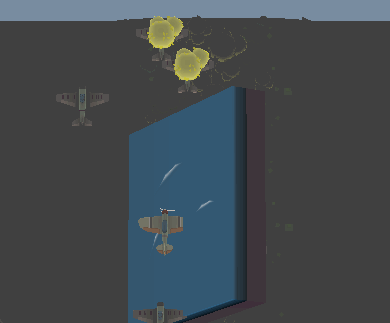Project Dusk #5 - Testing scene graph webbuild 3
Testing the build of last week revealed a render issue on older Android smartphones. The issue was that the depth buffer resolution was significantly lower than on other systems. Adjusting the depth range to a small slice helped fixing this issue.
So let's start with the current version of this week:
It doesn't play any different compared to the previous version though visually it has changed quite a bit:
- The ground is desaturated by a shader for a fog like effect - also because it's too distracting otherwise
- There's more ground and less water
- Clouds are drawn to create more feeling of flying
- The left and right of the screen is now overdrawn with a border to handle different aspect ratios
Technically there are a few more changes. I am trying to move towards enabling reloading game data while the game is running. A JSON file is parsed and I am reading values that modify certain game parameters. The idea is, that I want to life edit enemy patterns and their behavior and that is difficult to do in C. I started with reloading the shader, which brought me some annoying buggy effects:

I eventually figured out what the reason was, but it doesn't matter much - let's just say that when unloading a shader and it's locations, you better don't use those any more.
When thinking about how to add enemy patterns and UI, I decided to pick up the original idea again: creating a scene format and eventually an editor for that. While the later is currently not the highest priority for me, collecting some experience with creating a format that is loaded by C code is a good direction to start with.
My current (working) draft is this here:
1 {
2 "root": "ui",
3 "objects": {
4 "ui-border": {
5 "type": "MeshRendererComponent",
6 "mesh": "ui-border",
7 "litAmount": 1
8 },
9 "border-element": {
10 "components": [ "ui-border" ]
11 },
12 "border-group": {
13 "children": [
14 {
15 "prefab": "border-element",
16 "position": [ 0, 6, 0 ]
17 },
18 {
19 "prefab": "border-element",
20 "position": [ 0, 2, 0 ]
21 },
22 {
23 "prefab": "border-element",
24 "position": [ 0, -2, 0 ]
25 },
26 {
27 "prefab": "border-element",
28 "position": [ 0, -6, 0 ]
29 }
30 ]
31 },
32 "ui": {
33 "children": [
34 {
35 "prefab": "border-group",
36 "position": [ 8, 0, 0 ]
37 },
38 {
39 "prefab": "border-group",
40 "position": [ -8, 0, 0 ],
41 "rotation": [ 0, 0, 180 ]
42 }
43 ]
44 }
45 }
46 }What this does is a description of an object, its children and components. It's a little bit similar to what I worked out with Raygine, though there are some deviations for the sake of human readability:
- It's not a nested format; nested formats have in my experience lot's of issues with readability and maintainability. While it is convenient to see the hierarchical structure in a nested format, it quickly becomes a burden after the 4th indention level or so.
- It's a flat list with named references: The object keys are the unique identifiers and the elements refer to each other using those keys.
- Objects and components are in one list.
- References are instantiations: when referring to an id, the target is instantiated and returned. This enables nested prefabs and easy reuse of objects: The "border-element" is a prefab and is used multiple times in the "border-group". Values can be overridden in the instantiation step. It doesn't allow nested overrides yet. I will work this out once I need that.
- Currently it only supports the MeshRendererComponent - that's a part that's hard wired. I am thinking of utilizing the code I started writing 3 weeks ago which led to the type system approach; then I could create a schema description in C and use that to initialize component data via JSON.
It's a little weird that I am now working on a concrete game and trying to fit editor like features to the test whereas the Raygine project was the reverse. Solving concrete problems is a good way to find out what's really needed and what's not. Though I really miss some visual editing tooling here already.
I am thinking of making a video about the approach I am using here and publishing the scene graph code base as a library. It's really versatile, even if it isn't finished yet. It's proving itself to be quite stable and I think it could be useful for others too.
